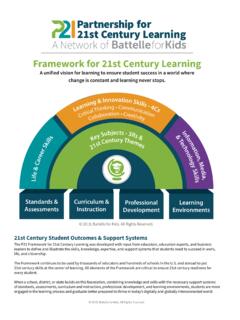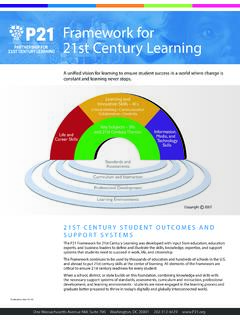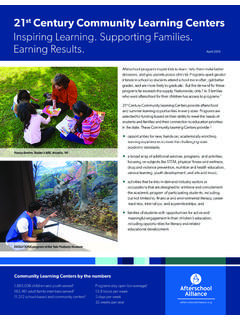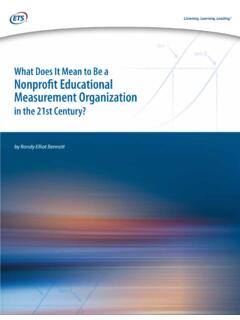Transcription of P21 Framework Definitions - static.battelleforkids.org
1 P21 Framework Definitions To help practitioners integrate skills into the teaching of key academic subjects, the Partnership has developed a unified, collective vision for learning known as the Framework for 21st Century Learning. This Framework describes the skills, knowledge and expertise students must master to succeed in work and life; it is a blend of content knowledge, specific skills, expertise and literacies. Every 21st century skills implementation requires the development of key academic subject knowledge and understanding among all students. Those who can think critically and communicate effectively must build on a base of key academic subject knowledge. Within the context of key knowledge instruction, students must also learn the essential skills for success in today's world, such as critical thinking, problem solving, communication and collaboration. When a school or district builds on this foundation, combining the entire Framework with the necessary support systems standards, assessments, curriculum and instruction, professional development and learning environments students are more engaged in the learning process and graduate better prepared to thrive in today's global economy.
2 While the graphic represents each element distinctly for descriptive purposes, the Partnership views all the components as fully interconnected in the process of 21st century teaching and learning. P21 Framework Definitions Page 1 of 9. Publication date: 5/15. 21st CENTURY STUDENT OUTCOMES. The elements described in this section as 21st century student outcomes (represented by the rainbow) are the knowledge, skills and expertise students should master to succeed in work and life in the 21st century. Key SUBJECTS AND 21st CENTURY THEMES. Mastery of key subjects and 21st century themes is essential for all students in the 21st century. Key subjects include: English, reading or language arts World languages Arts Mathematics Economics Science Geography History Government and Civics In addition to these subjects, we believe schools must move to include not only a focus on mastery of key subjects, but also promote understanding of academic content at much higher levels by weaving 21st century interdisciplinary themes into key subjects.
3 Global Awareness Using 21st century skills to understand and address global issues Learning from and working collaboratively with individuals representing diverse cultures, religions and lifestyles in a spirit of mutual respect and open dialogue in personal, work and community contexts Understanding other nations and cultures, including the use of non-English languages Financial, Economic, Business and Entrepreneurial Literacy Knowing how to make appropriate personal economic choices Understanding the role of the economy in society Using entrepreneurial skills to enhance workplace productivity and career options Civic Literacy Participating effectively in civic life through knowing how to stay informed and understanding governmental processes Exercising the rights and obligations of citizenship at local, state, national and global levels Understanding the local and global implications of civic decisions P21 Framework Definitions Page 2 of 9.
4 Publication date: 5/15. Health Literacy Obtaining, interpreting and understanding basic health information and services and using such information and services in ways that enhance health Understanding preventive physical and mental health measures, including proper diet, nutrition, exercise, risk avoidance and stress reduction Using available information to make appropriate health-related decisions Establishing and monitoring personal and family health goals Understanding national and international public health and safety issues Environmental Literacy Demonstrate knowledge and understanding of the environment and the circumstances and conditions affecting it, particularly as relates to air, climate, land, food, energy, water and ecosystems Demonstrate knowledge and understanding of society's impact on the natural world ( , population growth, population development, resource consumption rate.)
5 Etc.). Investigate and analyze environmental issues, and make accurate conclusions about effective solutions Take individual and collective action towards addressing environmental challenges ( , participating in global actions, designing solutions that inspire action on environmental issues). LEARNING AND INNOVATION SKILLS. Learning and innovation skills increasingly are being recognized as those that separate students who are prepared for a more and more complex life and work environments in the 21st century, and those who are not. A focus on creativity, critical thinking, communication and collaboration is essential to prepare students for the future. CREATIVITY AND INNOVATION. Think Creatively Use a wide range of idea creation techniques (such as brainstorming). Create new and worthwhile ideas (both incremental and radical concepts). Elaborate, refine, analyze and evaluate their own ideas in order to improve and maximize creative efforts Work Creatively with Others Develop, implement and communicate new ideas to others effectively Be open and responsive to new and diverse perspectives; incorporate group input and feedback into the work Demonstrate originality and inventiveness in work and understand the real world limits to adopting new ideas P21 Framework Definitions Page 3 of 9.
6 Publication date: 5/15. View failure as an opportunity to learn; understand that creativity and innovation is a long-term, cyclical process of small successes and frequent mistakes Implement Innovations Act on creative ideas to make a tangible and useful contribution to the field in which the innovation will occur CRITICAL THINKING AND PROBLEM SOLVING. Reason Effectively Use various types of reasoning (inductive, deductive, etc.) as appropriate to the situation Use Systems Thinking Analyze how parts of a whole interact with each other to produce overall outcomes in complex systems Make Judgments and Decisions Effectively analyze and evaluate evidence, arguments, claims and beliefs Analyze and evaluate major alternative points of view Synthesize and make connections between information and arguments Interpret information and draw conclusions based on the best analysis Reflect critically on learning experiences and processes Solve Problems Solve different kinds of non-familiar problems in both conventional and innovative ways Identify and ask significant questions that clarify various points of view and lead to better solutions COMMUNICATION AND COLLABORATION.
7 Communicate Clearly Articulate thoughts and ideas effectively using oral, written and nonverbal communication skills in a variety of forms and contexts Listen effectively to decipher meaning, including knowledge, values, attitudes and intentions Use communication for a range of purposes ( to inform, instruct, motivate and persuade). Utilize multiple media and technologies, and know how to judge their effectiveness a priori as well as assess their impact Communicate effectively in diverse environments (including multi-lingual). Collaborate with Others Demonstrate ability to work effectively and respectfully with diverse teams Exercise flexibility and willingness to be helpful in making necessary compromises to accomplish a common goal P21 Framework Definitions Page 4 of 9. Publication date: 5/15. Assume shared responsibility for collaborative work, and value the individual contributions made by each team member INFORMATION, MEDIA AND TECHNOLOGY SKILLS.
8 People in the 21st century live in a technology and media-driven environment, marked by various characteristics, including: 1) access to an abundance of information, 2) rapid changes in technology tools, and 3) the ability to collaborate and make individual contributions on an unprecedented scale. Effective citizens and workers of the 21st century must be able to exhibit a range of functional and critical thinking skills related to information, media and technology. INFORMATION LITERACY. Access and Evaluate Information Access information efficiently (time) and effectively (sources). Evaluate information critically and competently Use and Manage Information Use information accurately and creatively for the issue or problem at hand Manage the flow of information from a wide variety of sources Apply a fundamental understanding of the ethical/legal issues surrounding the access and use of information MEDIA LITERACY.
9 Analyze Media Understand both how and why media messages are constructed, and for what purposes Examine how individuals interpret messages differently, how values and points of view are included or excluded, and how media can influence beliefs and behaviors Apply a fundamental understanding of the ethical/legal issues surrounding the access and use of media Create Media Products Understand and utilize the most appropriate media creation tools, characteristics and conventions Understand and effectively utilize the most appropriate expressions and interpretations in diverse, multi-cultural environments ICT (Information, Communications and Technology) LITERACY. Apply Technology Effectively Use technology as a tool to research, organize, evaluate and communicate information P21 Framework Definitions Page 5 of 9. Publication date: 5/15. Use digital technologies (computers, PDAs, media players, GPS, etc.)
10 , communication/networking tools and social networks appropriately to access, manage, integrate, evaluate and create information to successfully function in a knowledge economy Apply a fundamental understanding of the ethical/legal issues surrounding the access and use of information technologies LIFE AND CAREER SKILLS. Today's life and work environments require far more than thinking skills and content knowledge. The ability to navigate the complex life and work environments in the globally competitive information age requires students to pay rigorous attention to developing adequate life and career skills. FLEXIBILITY AND ADAPTABILITY. Adapt to Change Adapt to varied roles, jobs responsibilities, schedules and contexts Work effectively in a climate of ambiguity and changing priorities Be Flexible Incorporate feedback effectively Deal positively with praise, setbacks and criticism Understand, negotiate and balance diverse views and beliefs to reach workable solutions, particularly in multi-cultural environments INITIATIVE AND SELF-DIRECTION.











